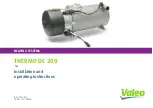
ENGLISH
29
The reason for a resistance error may be poorly contacting and/or worn connection terminals.
Therefore, if this error occurs, check them for proper fit and, if worn, replace them with new
ones.
9.3
Overheating Switch
The welding process aborts if the temperature of the transformer in the welding unit is too high.
The overheating circuit breaker for the transformer stops the welding if the temperature reading
is too high and the remaining welding time is longer than 800 seconds. The display and the
welding report will show an “Overheated” message.
9.4
Indication of Power Supply Failure at the Last Welding
The message “Power Supply Failure Last Welding” indicates that the previous welding aborted
because of a power supply failure. The reason may be too weak a generator or too long or too
thin an extension cable, or a tripped cut-out in the mounting box. The next welding operation is
still possible after acknowledging the message by pressing the STOP/RESET key.
10
Configuring the Welding Unit
With the operator identity card, the welding unit can be
reconfigured
Display 17
>Settings -M-
Recording -M-
.
When the MENU key is pressed, the “Enter Menu
Code” message appears on the screen. After the code was read
from the operator card, the selection menu in Display 17 shows.
At “Settings,” the parameters related to the welding unit itself and
its operation can be set. At “Recording,” the traceability data that
have to or need not be recorded and written into the reports can
be enabled or disabled. The desired sub-menu is selected using the
ñ
and
ò
arrow keys. Then to
access that sub-menu, press the MENU key.
In both parts of the configuration menu, use the
ñ
,
ò
arrow keys to select the desired set-up
option. Use the
ð
arrow key to toggle between “on” and “off” for that set-up option.
If a “M” is shown next to a set-up option, this indicates that a sub-menu is accessible here by
pressing the MENU key.
Press the START/SET key to confirm the set-up and save it to memory.
10.1
Understanding the “Settings” Sub-menu
“AutoWeld on” means that the AutoWeld feature for the easy
definition of
Display 18
*** SET-UP MENU ***
>AutoWeld on
Check Cd Expiry off
Memory Control on
welding parameters (see Sect. 5.5) can be used,
“off,” that the feature is not available.
“Check Code Expiry on” means that the welder identification code
has to be current and not expired (default period of validity
2 years from code issuance), or the welding operation cannot be
started, “off,” that the validity of the code is not checked at all.
“Memory Control on” means that when the system memory is full
of reports,
Display 19
*** SET-UP MENU ***
Manual Input -M-
Wldr Code Option-M-
>Language -M-
the unit will be blocked until the reports are printed
or downloaded, “off,” that it works but that the oldest report
will be overwritten.
“Manual Input on” means that the manual input of welding
parameters (see Sect. 7) is possible, “off,” that the manual input
is not allowed.
“Welder Code Options – M – ” means that by pressing the MENU
key, the user can access a sub-menu that allows determining
when the welder code, if it is enabled at “Recording,” has to be
entered:always, i. e. before evey single welding operation, only
before the first welding operation after switching the unit on or
only after the first welding operation of a new day/date.
“Language – M – ” means that by pressing the MENU key, the
Display 20
*** SET-UP MENU ***
Date/Time -M-
Buzzer Volume -M-
>Temp. Unit -M-
user
can access a sub-menu for selecting the display and report
language (see Sect. 10.1.1).
“Date/Time – M – ” means that by pressing the MENU key, the user
can access a sub-menu for setting the clock (see Sect. 10.1.2).
Содержание ROWELD ROFUSE Print+ V2
Страница 70: ...68 Notes ...
Страница 71: ...69 Notes ...
















































